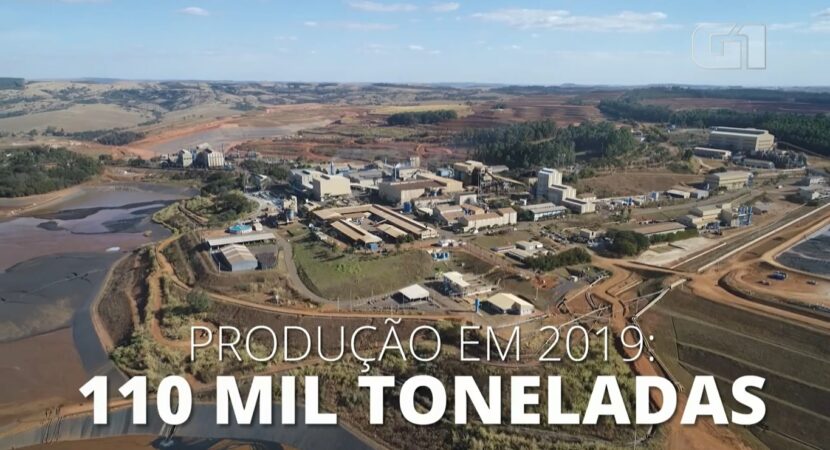
The largest reserve of niobium in operation on the planet, is located in Brazil in the city of Araxá in Minas Gerais, which is currently produced by CBMM and exported to more than 50 countries.
In Brazil, the Companhia Brasileira de Metalurgia e Mineração holds more than 90% of the world's active niobium reserves. Despite controlling 80% of the world supply, Brazil is not the only country with reserves of this metal. CBMM announced on November 21 the investment in a Singaporean company dedicated to Graphene technology.
According to data from the National Mining Agency (ANM), in addition to Brazil, the other two countries participating in the global market are Canada and Australia. According to data from the Brazilian Mining Institute (Ibram), there are 85 quantifiable deposits in the world, including Canada, Australia, Russia, the United States and several countries in Africa.
On several occasions, our president Jair Bolsonaro testified with pride about this much-desired mineral, which, during a trip to Japan in the middle of the year, showed a niobium chain and cutlery on video. Despite the advertisements made by our president helping metal to gain fame, the market is still very restricted.
The largest niobium reserve in operation on the planet is located in the city of Araxá, in the region of Triângulo Mineiro and Alto Paranaíba. In Araxá alone, reserves are estimated at more than 800 million tons of ore, enough volume to guarantee even more than 100 years of production, maintaining the current demand. But if mineral deposits in underground rocks are considered, the exploration capacity is estimated at more than 400 years.
But in addition to the Araxá reserves, there is niobium production in Goiás and in small quantities in Amazonas and Rondônia, in addition to unexplored reserves in indigenous areas.
Currently, the niobium produced in Minas Gerais by CBMM is exported to more than 50 countries, with greater potential to supply steel companies.
- Maritime transport company in RJ hires helpers and seafarers
- Vacancies for welder, rigger, painter, operator, mechanic, electrician, technicians, pumpers and mariners
The G1 visited the planet's largest operating niobium reserve. Understand below what it is for, its importance for the economy and how this mineral extracted in Minas Gerais and so abundant in our country is exploited.
Exploration is all done in the open, without the use of explosives, only with excavators. Mining is just one of the 15 stages necessary to reach the final products, which also include concentration, refining (to reduce phosphorus and lead levels) and metallurgy processes.
Of the material that is removed from the soil, only a fraction, around 2,5%, is niobium. For every 1 ton of ore extracted from the mine, only 15 kg of ferroniobium are produced. The remainder is sent to tailings dams.
Around 300 tons of final products are produced daily, leaving the Araxá industrial complex in bags, cans and cylinders, which vary from 10 kg to 2 tons. Around 90% of everything produced is destined for foreign countries.
The metal is used on a larger scale in the production of special steels and superalloys. Niobium has a “refining” function. Only 400 grams per ton are enough to generate lighter and more resistant steels.
Niobium is sold in the form of ferroniobium alloy (with about two-thirds of niobium content and one-third of iron) and used in automobiles, airplane turbines, gas pipelines, ships, MRI machines, particle accelerators, lenses and even piercings and jewelry.
- TechnipFMC with opportunities to work on a PLSV vessel
- Elfe with updated offshore and onshore jobs for welder, electrician, technicians and more
According to agreements with the National Mining Agency (ANM), in Brazil, exports of products associated with niobium move around BRL 2 billion per year, despite being a much lower value for example than iron ore, representing less than 5% of sales of metallic substances abroad, the business has proved to be very profitable for CBMM.
In 2018, the company's revenue grew 55% and reached R$ 7,4 billion. Profit in 2018 was BRL 2,7 billion, which guaranteed the 2.000 employees a bonus of 6 additional extra salaries in the year.
Although CBMM is the only company to explore niobium in Araxá, the state of Minas Gerais owns part of the mine and receives a portion of the profits from niobium production, which in turn presents cash difficulties, and has announced its intention to privatize Codemig.
This month, the government managed to pass a bill that authorizes the sale of credits from the sale of niobium between 2020 and 2032, in order to guarantee the payment of the 13th of the servants and put an end to the installment of civil service salaries for a few months.
CBMM states that it will end the year with a record production of 110 tons of niobium, compared to a volume of 89 tons last year, with the main challenges being to expand the market and the number of customers around the world and convince more customers to adopt an input that is practically only produced in Brazil.
Besides CBMM, the other 2 producers operating in the world market are the Canadian Niobec and the Chinese CMOC, responsible for extracting niobium at the Catalão (GO) mine.










Air Force F-16 fighters…
True friend, what they shot down were…
Air Force F-16 fighters…
I would like to know what planet you live on…
Air Force F-16 fighters…
Everything is fine, 100-year secrecy,…
Air Force F-16 fighters…
Well... It's flying scrap... Typical...
Air Force F-16 fighters…
Which genocide are you talking about? Than…
I liked the opportunity. Is there an age restriction?…
The future is a steam engine…
For a walk, Saveiro. To work without…
The road is springy and…
Wow. They're talking about news like bread...
Yes I had a 1987 Monza Classic
I am interested, I have experience, in the commercial area, any…
Why 300 km/h if there is technology…